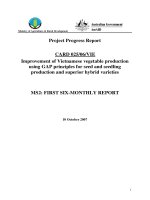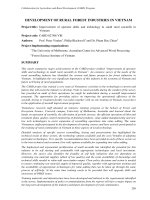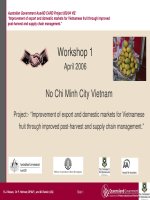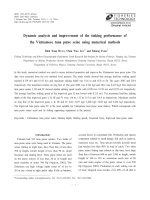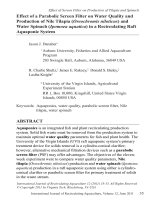Quality improvement of spotted babylon (babylo
Bạn đang xem bản rút gọn của tài liệu. Xem và tải ngay bản đầy đủ của tài liệu tại đây (2.09 MB, 111 trang )
การปรับปรุงคุณภาพพอแมพันธุห อยหวาน Babylonia areolata
ดวยอาหารเสริมกรดไขมันไมอิ่มตัวสูง
นายสราวุธ แสงสวางโชติ
วิทยานิพนธนี้เปนสวนหนึง่ ของการศึกษาตามหลักสูตรปริญญาวิทยาศาสตรดุษฎีบัณฑิต
สาขาวิชาวิทยาศาสตรทางทะเล ภาควิชาวิทยาศาสตรทางทะเล
คณะวิทยาศาสตร จุฬาลงกรณมหาวิทยาลัย
ปการศึกษา 2552
ลิขสิทธิ์ของจุฬาลงกรณมหาวิทยาลัย
QUALITY IMPROVEMENT OF SPOTTED BABYLON (Babylonia areolata)
BROODSTOCK WITH HIGHLY UNSATURATED
FATTY ACID-SUPPLEMENTED FEED
Mr. Sarawut Sangsawangchote
A Dissertation Submitted in Partial Fulfillment of the Requirements
for the Degree of the Doctor of Philosophy Program in Marine Science
Department of Marine Science
Faculty of Science
Chulalongkorn University
Academic Year 2009
Copyright of Chulalongkorn University
iv
สราวุธ แสงสวางโชติ: การปรับปรุงคุณภาพพอแมพันธุหอยหวาน Babylonia areolata ดวย
อาหารเสริมกรดไขมันไมอิ่มตัวสูง. (QUALITY IMPROVEMENT OF SPOTTED BABYLON
(Babylonia areolata) BROODSTOCK WITH HIGHLY UNSATURATED FATTY ACID–
SUPPLEMENTED FEED) อ. ที่ปรึกษาวิทยานิพนธหลัก: รศ. ดร. สมเกียรติ ปยะธีรธิติวรกุล,
อ. ที่ปรึกษาวิทยานิพนธรวม: อ. ดร. นิลนาจ ชัยธนาวิสุทธิ์, 101 หนา.
การศึกษาผลของกรดไขมัน และกรดไขมันอะราคิโดนิกตอความสามารถในการสืบพันธุของพอแม
พันธุหอยหวานโดยแบงการทดลองเปน 2 การทดลอง การทดลองแรกใชเวลา 120 วัน ประเมิน
ความสามารถการสืบพันธุ คุณภาพของไขและตัว ออน และกรดไขมันของไขหอยหวาน เมื่อใหอาหาร
ธรรมชาติคือ ปลาขางเหลืองและอาหารผสม 4 สูตรที่มีระดับไขมัน 5% และ15% จากน้ํามันปลาทูนา (TO)
และน้ํามันผสมของน้ํามันปลาทูนากับน้ํามันถั่วเหลือง (MO) (อัตราสวน 3:2) ผลของอาหารควบคุม (เนื้อ
ปลา) พบวาระดับกรดไขมัน 20:5n-3, 22:6n-3 และ 20:4n-6ในฝกไขมีคาต่ํา เมื่อเปรียบเทียบกับอาหาร
สูตรอื่น โดยสูตรอาหาร 5%TO ใหผลของกรดไขมันในฝกไขสูงที่สุด และความสามารถการสืบพันธุสูงที่สุด
พบในหอยเพศเมียที่ไดรับอาหารสูตร 5%TO แตผลของคุณภาพของไขและตัวออน ระยะเวลาการทดสอบ
ความทนทานตอการอดอาหารไมตางกัน และคากรดไขมันสําคัญในฝกไขจากแมพันธุที่กินอาหารสูตร
5%TO มีความแตกตางอยางมีนัยสําคัญทางสถิติสูงกวาอาหารอื่น อาหารผสมที่เติมน้ํามันปลาทูนาใหผลดี
ตอการวางไขและทําใหฝกไขมีระดับของกรดไขมันสําคัญสูงขึ้นเมื่อเปรียบเทียบกับการใชเนื้อปลา สําหรับ
การทดลองที่สองไดศึกษาผลของระดับกรดอะราคิโดนิกตอความสามารถในการวางไข คุณภาพของไขและ
ตัวออน และองคประกอบของกรดไขมันในไขหอยหวาน โดยใชอาหาร 5 สูตร ที่มีสวนผสมของอาหาร
เหมือนกัน แตมีการเสริมปริมาณของกรดอะราคิโดนิก (ARA) ตางกัน 5 ระดับ (0%, 0.4%, 0.8%, 1.2%
และ 1.6%) ผลการทดลองพบวาอาหารเสริม ARA มีผลตอการวางไข (จํานวนการวางไขรวมและความถี่
การออกไขตอเดือน) โดยจํานวนครั้งของการวางไขและความถี่ในการออกไขตอเดือนมีคาเพิ่มขึ้นตามการ
เพิ่มขึ้นของระดับ ARA โดยหอยเพศเมียที่กินอาหารสูตร 5 ใหผลการวางไขสูงสุด (25.5 ครั้ง), สูตร 4 (23.0
ครั้ง), สูตร 3 (22.0 ครั้ง), สูตร 1 (17.5 ครั้ง) และ สูตร 2 (15.5 ครั้ง) สําหรับผลคุณภาพของไข (ตัวออนใน
ฝก ไข , ขนาดของฝ กไข, ระยะเวลาในการฟก และอั ตราการฟ ก) ไมมีค วามสั มพัน ธ กับ การเสริม ARA
นอกจากนี้คุณภาพของลูกหอยวัยออน (ความทนทานตอความเค็มต่ําและความทนทานตอการอดอาหาร
ของลูกหอยวัยออน) ไมมีคาเพิ่มขึ้นตามการเพิ่มขึ้นของระดับ ARA การศึกษาในครั้งนี้สามารถสรุปไดวา
การเสริมระดับ ARA ในปริมาณสูงมีผลตอคคุณภาพการวางไขของหอยหวาน แตไมมีผลตอคุณภาพของไข
และตัวออนและองคประกอบของกรดไขมันในฝกไข
สาขาวิชา วิทยาศาสตรทางทะเล
ปการศึกษา 2552
ลายมือชื่อนิสิต……………………………………………………..
ลายมือชื่อ อ.ที่ปรึกษาวิทยานิพนธหลัก……….………………..….
ลายมือชื่อ อ.ที่ปรึกษาวิทยานิพนธรวม……………..……………...
v
# # 4873857423 : MAJOR MARINE SCIENCE
KEYWORDS
:
BROODSTOCK/
Babylonia
areolata/
REPRODUCTIVE
PERFORMANCE/
CONDITIONING DIETS/ FATTY ACID, ARACHIDONIC ACID/ EGG AND LARVAE QUALITY
SARAWUT SANGSAWANGCHOTE : QUALITY IMPROVEMENT OF SPOTTED BABYLON
(Babylonia
areolata)
BROODSTOCK
WITH
HIGHLY
UNSATURATED
FATTY
ACID–
SUPPLEMENTED FEED. THESIS ADVISOR : ASSOC. PROF. SOMKIAT PIYATIRATITIVORAKUL,
Ph.D., THESIS CO-ADVISOR : NILNAJ CHAITANAWISUTI, Ph.D., 101 pp.
This study was designed to study effects of fatty acids and arachidonic acid on reproductive
performance of hatchery-reared broodstock spotted babylon, Babylonia areolata. The study was divided into
two experiments. The first experiment, a 120-day feeding trial was conducted to evaluate reproductive
performance, egg and larval quality and egg fatty acid composition in spotted babylon broodstock fed natural
food (fresh meat of carangid fish, Selaroides leptolepis,) and four experimental formulated diets containing 5%
or 15% of dietary lipid from tuna oil (TO) and a mixture of tuna oil and soybean oil (MO) (ratio 3:2) labeled as
5%TO, 15%TO, 5%MO and 15%MO respectively. Using trash carang resulted the lowest levels of in 20:5n-3,
22:6n-3 and 20:4n-6 fatty acids compared to those of all experimental diets. The highest content of total fatty
acids was found in the 5%TO diet. The best reproductive performance were found only for females fed the
5%TO diets, but egg and larval quality showed no variability among females fed. No significant differences
were observed in survival duration in the starvation tolerance test for females fed trash fish or any of the
experimental diets. However, the fatty acid profile of egg capsules was significantly affected by the dietary
treatments. The levels of major fatty acids (20:5n-3, 22:6n-3 and 20:4n-6) in egg capsules produced from
females fed diets containing 5% tuna oil (5%TO) was significantly higher than those females fed trash fish or
other experimental diets. We therefore conclude that formulated diets with fish oil resulted in successful
reproduction and high essential fatty acids in egg capsules comparable to the use of trash fish. The second
experiment studied on the effects of arachidonic acid in broodstock diet on spawning performance, egg and
larval quality and fatty acid composition of eggs from broodstock spotted babylon (B. areolata). A formulated
diet containing similar compositions was supplemented with five levels of arachidonic acid (20:4n-6, ARA);
0% (1), 0.4% (2), 0.8% (3), 1.2% (4) and 1.6% (5) ARA, respectively. Results showed that spawning quality
(total number of spawning and monthly spawning frequency) were affected by ARA supplementation. The
total number of spawning and monthly spawning frequency throughout the experiment increased with an
increased supplemented of ARA levels. Females fed on diet 5 had the highest total number of spawn (25.5),
followed by the diet 4 (23.0), diet 3 (22.0), basic diet (17.5) and diet 2 (15.5). While the egg quality (number
of fertilized eggs in capsule, length and width of egg capsules, egg incubation time and hatching rate) were not
affected by ARA supplementation. For larval quality, ARA did not enhance tolerance to low salinity stress and
starvation test together with increasing the levels of dietary ARA in B. areolata broodstock. These results
indicated that high level of dietary arachidonic had a positive effect on spawning performance of B. areolata
broodstock and high level of arachidonic improved spawning performance but not for egg and larval quality
and fatty acid composition of egg capsules.
Department :
Marine Science
Student’s Signature
Field of Study : Marine Science
Advisor’s Signature
Academic Year : 2009
Co-Advisor’s Signature
vi
ACKNOWLEDGEMENTS
I would like to very great acknowledgement to my advisor Associate Professor Dr.
Somkiat Piyatiratitivorakul and express my deepest gratitude to my co-ordinate advisor Dr.
Nilnaj chaitanawisuti for their advices and supports throughout this thesis.
My special thanks to my committees, Dr. Mali Boonyaratpalin, Assistant Professor
Dr. Voranop Viyakarn, Dr. Sorawit Powtongsook, Associate Professor Dr. Chaloen
Nitithamyong and Associate Professor Dr. Thaithaworn Lirdwitayaprasit for their worthy
suggestion and discussion.
I would like to acknowledge the staff of the Research Unit for Commercial
Aquaculture of the Spotted Babylon, Aquatic Resources Research Institute, Chulalongkorn
University, Petchaburi Province, Thailand, especially Ms. Wannanee Santhaweesuk for her
kindness.
I wish to thank for many kindly and suggestion from Assistant Professor Dr. Sirusa
Kritsanapuntu, Associate Professor Nittharat Paphavasit, Associate Professor Dr. Ajcharaporn
Piumsomboon and Assistant Professor Itchika Sivaipram
I would like to thank member of Center of Excellent for Marine and Biotechnology
(CEMB) Dr. Oraporn Meunpol, Mr. Seri Donnue, Mr. Ekarat Phookung, Ms. Oranoot
Prosansri and others, Department of Marine science of Chulalongkorn University for
suggestion and support.
I wish to thank my friends Dr. Vichaya Gunbua, Lt.Cdr. Piyachat Wongjamras, Dr.
Supichaya Wongchinawit and Mrs.Saranya Ruksaree for their kindly encouragement.
I would like to thank the Support Research Fund of Graduate (CU Graduate School
Thesis Grant), Chulalongkorn University for partial support.
Finally, I deeply special thanks to my family, my father, my mother, my wife, two
younger brothers and relatives who always support, encourage and understanding during my
study.
CONTENTS
Page
Abstract in Thai..............................................................................................................
iv
Abstract in English ……………………………………………………………
v
Acknowledgements...………………………………………………………….
vi
List of Tables …………………………………………………………………
ix
List of Figures ………………………………………………………………...
x
CHAPTERS
1. Introduction ………………………………………………………………...
1
2. Literature review……………………………………………………………
Biological aspects of the spotted babylon ………………………………….
7
Fatty acids…………………………………………………………………..
13
Type of Fatty acids………………………………………………………
13
Essential fatty acid and role in maturation and fecundity………………..
15
3. Performance, egg and larval quality and fatty acid composition of
hatchery – reared spotted babylon (Babylonia areolata) broodstock fed
natural and formulated diets under hatchery conditions
Introduction………………………………………………………………
24
Materials and methods……………………………………………...……
26
Results………………………………………………………………...….
34
Discussion………………………………………………………………..
45
viii
CONTENTS (Cont.)
Page
4. Effects of arachidonic acid levels in broodstock diets on spawning
performance, egg and larval quality and fatty acid composition of eggs and
broodstock spotted babylon (B. areolata)……………………………………..
Introduction……………………………………………….………………...
51
Materials and methods…………………………………………..…………
53
Results………………………………………………………………………
62
Discussion…………………………………………………………………
73
5. Summary……………………………………………………………………
79
References……………………………………………………………………
81
Appendices……………………………………………………………………
88
Appendix A: Fatty acids determination…………………………………….
89
Appendix B: Proximate analysis determination…………………………….
97
Biography……………………………………………………………………..
101
ix
LIST OF TABLES
Table
3-1
Page
Experimental formulated diets for B. areolata broodstock
containing different sources and levels of dietary lipids .…………...
3-2
Fatty acid composition (mg/100g wet weight) of experimental
diets……………………...………………………………………...…
3-3
32
35
Reproductive performance and egg and larval quality of B. areolata
broodstock fed on different experimental diets and control diet for
120 days……………………………………………………………...
3-4
40
Biochemical composition (%) and fatty acid composition (mg fatty
acid /100g wet weight) of egg capsules produced from B. areolata
broodstock fed different experimental diets (n = 3) for 120 days……
4-1
Experimental formulated diets for B. areolata broodstock
supplemented with various levels of arachidonic acid. ......................
4-2
63
Reproductive performance and egg and larval quality of B. areolata
broodstock fed different experimental diets for 120 days…………….
4-4
55
Fatty acid composition (mg/100g wet weight) of experimental
formulated diets for B. areolata broodstock…………………………
4-3
43
67
Biochemical composition (%) and fatty acid composition (mg fatty
acid /100g wet weight) of egg capsules produced from B. areolata
broodstock fed different experimental diets (n = 3) for 120 days…...
71
x
LIST OF FIGURES
Figure
Page
2-1
The spotted babylon (B. areolata, Link 1807)…………………………..
2-2
Reproductive organs (upper) and sex differentiation (lower) of
female spotted babylon B. areolata …………………………………
2-3
8
10
Reproductive organs (upper) and sex differentiation (lower) of male
spotted babylon B. areolata………………………….........................
11
2-4
Egg laying of broodstock spotted babylon under hatchery conditions
12
2-5
Life cycle of the B. areolata ...………………………………………
12
3-1
Fresh meat of carangid fish; (Selaroides leptolepis) used as control
food (a) and formulated experimental diets molded in round shape
(b)………………………………………………………………….…
3-2
Feeding of B. areolata broodstock on experimental formulated diets
within feeding tray by using proboscis ...……………………………
4-1
33
37
Commercial grade of arachidonic acid namely Arbita (Suntory
company, Osaka, Japan) used in this study .………………………...
56
1A
Chromatogram of standard fatty acid………………………………..
94
2A
Chromatogram of fatty acid in egg capsules obtained from spotted
babylon females fed with ARA supplement diet…………………….
3A
95
Chromatogram of fatty acid in broodstock diet supplemented with
ARA for spotted babylon……………………………………………
96
CHAPTER I
INTRODUCTION
General background Information
The spotted babylon, Babylonia areolata Link, 1807, is now the most
important marine gastropod for human consumption in Thailand, where the largersized (>450 mm) are used for the fried and steamed spotted babylon in sea food
restaurants. Spotted babylon is abundant and widely inhabits littoral regions in the
Gulf of Thailand, especially in the muddy sand areas of which not exceeding 10-20 m
depth. However, natural stocks decrease widely from year to year due to continuous
exploitation in various traditional fishing areas, confronting to the chronic supply
shortage particularly in the larger size classes. Decreased production results in
increasing in price and demand. It has come under significant study in recent years to
protect spotted babylon as an important renewable marine resource and to increase
market supply. Spotted babylon have been the subject of recent studies, particularly
on their fishery and aquaculture because of their economic importance and decreasing
natural stocks. One possible solution to over-exploitation is juvenile production in
hatcheries for reseeding in natural areas. For spotted babylon aquaculture, the
remarkable success of spotted babylon cultivation has instigated a widespread interest
in developing the appropriate aquaculture systems as a mean of stock enhancement
and increasing market supply. From an aquaculture point of view, spotted babylon has
many desirable biological attributes for profitable aquaculture production, thus
spotted babylon is now promising as a new candidate for aquaculture in Thailand.
2
Considerable interest has been recently developed regarding the commercial culture
of spotted babylon in Thailand due to a growing demand and an expanding of
domestic and export market. Early attempts to produce spotted babylon seedling met
with failure more frequently than success. Although hatchery-based cultivation for
large-scale production of spotted babylon is considered to be technically feasible, the
successful techniques in the laboratory were not directly transferable to the
commercial operations, where large numbers of spotted babylon seedling needed to be
produced in high volume, intensive, factory-like systems. As spotted babylon culture
is a nascent industry compared with many marine bivalve and gastropod cultures,
further applied research is then necessary to develop an economically viable culture
operation for decreasing the maintenance time and production costs of spotted
babylon during growing-out phase. However, few studies exist concerning the biology
and culture of spotted babylon but these basic information is needed in order to
develop optimal rearing protocol for commercial spotted babylon culture in Thailand.
Justification of this study
The spotted babylon, B. areolata, have been identified as important candidates
for aquaculture in Thailand. In recent year, some information has been published on
the biology and ecology of spotted babylon and considerable progress has been made
in their aquaculture potentials. Techniques have now been developed to culture for all
stages of the life cycle of spotted babylon. The most critical period in the production
of spotted babylon is the larval stage. After hatching, the larvae need to be fed the live
feed. Consequently, at the end of the larval life stage, when the larvae metamorphose
into juveniles, the live food is replaced by dead fish or shellfish. It is generally
thought that most technical problems must be solved in the larval rearing phase of this
3
species. The survival rates from the hatching of the eggs until the weaning of the
larvae are not always stable, and mass mortality of larvae is common. Although,
considerable progress has been made during the past few years, the production of
juveniles is still one of the main bottlenecks for this species. The problems seem to be
the same for many species of both fish and shellfish, with poor reproducibility in
terms of survival, growth and quality as the main symptoms. This suggests that there
is a lack of investigation on various limiting factors upon growth and survival of
larvae and juveniles of this species. Among these factors, the effects of food items,
stocking density and egg quality seem to be ruled out as the principal cause. However,
the hatchery-based system for commercial operations is needed to be developed for
large numbers of spotted babylon seedling production in high volume, intensive,
factory-like systems.
Present problems
A major constraint to the development of the spotted Babylon, B. areolata,
aquaculture in Thailand is the insufficient supply of seed and high cost production.
Successful conditioning of broodstock B. areolata is still a crucial step for selective
breeding programs to produce a large quantity of eggs and larvae of good quality for
the growing industrial importance of this species in Thailand because large variability
in spawning events, hatchability, and larval and juvenile survival rates of the spotted
babylon has been observed during the same season between batches and hatcheries.
This variability remained high despite each batch of larvae being reared in a
standardized manner which included the control of larval density, water management
and the use of selected microalgal species. Production of good quality larvae is very
inconsistent (Nilnaj Chaitanawisuti and Sirusa Kritsanapuntu, 1997). One of the main
reasons for unpredictable larvae culture outputs is the variable quality of eggs and
4
larvae. Several factors affect egg and larvae quality in fish and shellfish species.
These are either endogenous (genotype, age, and size of broodstock, egg size) or
exogenous (egg management, broodstock feeding, bacterial colonisation of egg surface
(Ballestrazzi et al., 2003). In teleosts, nutrients such as protein, fatty acids, vitamin E,
ascorbic acids and carotenoids have been implicated in various reproductive-related
processes such as gonadal maturation, gamete quality and spawning performances.
Interaction between nutrients and reproductive processes, however, remains poorly
understood. Several studies have highlighted the importance of both quantity and
quality of dietary lipid on reproductive performances of broodstock (Ling et al.,
2006). Teruel, Millamena and Fermin (2001) reported that a higher amount of
essential nutrients such as protein, lipid and the highly unsaturated fatty acid, e.g.
20:4n-6, 20:5n-3, 22:6n-3 in the artificial diet influenced the increased reproductive
performance for abalone, Haliotis asinina. Utting and Millican (1997) reported that
the number of eggs produced and polyunsaturated fatty acid (PUFA) composition of
the eggs of marine bivalves (scallops, oysters and clams) are influenced by the
quantity and quality of lipid in microalgae diet supplements. Under optimal hatchery
rearing conditions, differences in initial egg lipid reserves may not necessary affect
subsequent larval growth and survival. In addition, the importance of lipid and PUFA
reserves, in particular, eicosapentaenoic acid, on 20:5n-3, during the development of
embryos and larvae can, however, be clearly demonstrated under more stressful
rearing conditions. It remains unclear which constituents are responsible for triggering
maturation, egg laying of broodstock, therefore, more detailed research on
reproductive performance is needed. There are no published studies on the influence
of nutrition on the reproductive performance of spotted babylon broodstock, despite
their importance in commercial aquaculture. Thus, there is a need to develop a
5
reliable technique for spotted babylon broodstock development through dietary
manipulation.
Concept of this study
One of the priorities for spotted babylon farming in Thailand is the
development of a fully formulated broodstock diet, which would provide good
spawning, and egg and larval quality but be free of the trash fish components
traditionally used by the farmer.
- Nutritional composition and quality of a broodstock diet is an important
contributor to egg and larval quality, since during ovarian development, dietary and
maternal reserves are mobilised and transported into the oocytes, where they provided
the energy and nutritional requirements for growth and development of the embryo
and the yolk sac larvae up till starting of exogenous feeding.
- Broodstock nutrition affects reproduction and egg quality and some feed
components are stress to greatly influence spawning quality in several fish species.
Several studies have highlighted the importance of both quantity and quality of
dietary lipid on reproductive performances of broodstock.
- Essential fatty acids are one of the nutritional factors, which greatly affect
spawning, egg and larval quality. More recently, attention has partly shifted to include
arachidonic acid (ARA: 20:4n-6), mainly because of its role in eicosanoid production
and the involvement of eicosanoids in a range of physiological functions, including
reproduction and egg development.
6
Targets of this study
This research targeted to solve the main problems concerning the broodstock
maintenance and conditioning in commercial hatcheries as following:
1) To develop the appropriate formulated broodstock diets, which provide
good spawning, and egg and larval quality as well as replacement the use of trash fish
traditionally used by the commercial farms.
2) To extend the use of new broodstock last longer in commercial hatcheries
because of their high expenses and unsufficience in supply.
3) To improve the linger used broodstock in commercial hatcheries for better
spawning quality and high quality of egg and larvae.
Objectives of this study
This dissertation targeted to provide information as a guideline for
development of appropriate practical diets for broodstock of Babylonia areolata in
commercial scales. Consequently, this study was focus on the improvement of
broodstock quality of B. areolata providing higher quality of eggs and larvae for
hatchery operations. Then, the present study had the special emphasis targets on two
parts of broodstocking conditioning diets as following:
Part 1: Reproductive performance, egg and larval quality and egg fatty acid
composition of hatchery-reared spotted babylon (B. areolata) broodstock fed natural
and formulated diets under hatchery conditions
Part 2: Effects of arachinodic acid levels in broodstock diets on spawning
performance, egg and larval quality and fatty acid composition of eggs and
broodstock spotted babylon (B. areolata)
CHAPTER II
LITERATURE REVIEW
Biological aspects of the spotted babylon
The spotted babylon, Babylonia areolata Link, 1807, belongs to the Phylum
Mollusca, Class Neogastropoda, Order Neogastropoda and Family Buccinidae. The Order
Neogastropoda is very large, with about 5,000 species and almost all members of this order
are marine benthic and carnivores. The family Buccinidae is one of the most diverse and
dominant groups of predatory gastropods that distribute around area of the seabed.
B. areolata shell is relatively thin but solid, elongate-ovate in shape, with a high, conical
spire and large, inflated body, spire whorls convex, distinctly shouldered below the sutures.
Outer surface is smooth and polished, white, with three spiral rows of large, quadrate brown
spots on body whorl, and one row of such spots on spire whorls, operculum large and thick
(Figure 2-1). The genus Babylonia is endemic to the Indo West Pacific area (Habe, 1965).
This species distributes from Ceylon and the Nicobar Islands through the Gulf of Thailand,
along the Vietnamese and Chinese coasts to Taiwan. In Thai seacoast, B. areolata is widely
distributed, abundant and inhabits in littoral regions in depth from 5 to 15 m in the Gulf of
Thailand such as the coastal waters of Rayong, Trad, Petchaburi, Prachuab Khiri Khan, and
Chumphon, provinces. Spotted babylon prefers the environment with salinity ranging from
28-35 ppt and water temperature of 25-30o C. They were found in variety of habitats such
as fine sand, coarse sand, sandy mud, and muddy sand. Spotted babylon spends most of
their life buried in the substrate with full or half bury in substrate of its shell height then
their distribution is limited by substrate in natural habitats.
8
Figure 2-1. The spotted babylon (B. areolata, Link 1807) (Nilnaj Chaitanawisuti, 2010 :
online)
The reproductive organs and sex differentiations of the male and female
spotted babylon B. areolata were demonstrated in Figure 2-2 and Figure 2-3. Nilnaj
Chaitanawisuti and Sirusa Kritsanapuntu (1997) reported that the spotted babylon lay
egg naturally under hatchery conditions all year round with maximum in summer
period during February – August (Figure 2-4). Broodstock with average shell length
of 5.0 – 7.0 cm spawned naturally during early morning. Most egg capsules were
individually attached to the sand substratum by a long, narrow stalk. Egg capsules
were moderately transparent and vasiform in shape, they were broad at the apex and
narrow toward the base. Each capsule possesses a short stalk (peduncle) that is
cemented to the substrate. The fertilized eggs are visible and suspended in albuminous
fluid inside the capsule. Egg capsules averaged 21.43+1.3 mm in length and 9.57+1.0
mm in width. An average female spotted babylon (5.7 cm long) spawned 46 egg
capsules (rang = 22 - 57). The average egg number per capsule was 851 eggs (range =
9
493 – 1,133), and the average egg diameter was 425.70 m. Spotted babylon
fecundity averaged 39,146 eggs per individual.
Nilnaj Chaitanawisuti and Sirusa Kritsanapuntu (1997) demonstrated the life
cycle of the spotted babylon (B. areolata) as showed in Figure 2-5. The fertilized eggs
are visible and suspended in albuminous fluid inside the capsule. The trochophore
larvae were developed from single cell to early veliger stage inside egg capsules
during the first 5 days. The veliger hatched through the apical opening into the water
column within 5 days after spawning. Veliger larvae were hatched at 28 to 30 ppt
salinity and 28 to 31oC water temperature. The average hatching rate was 95.0%. The
newly-hatched veliger larvae had a transparent, thin shell and two large, lobed velum.
The average shell length of veligers was 720.4+1.52 m. After hatching, veligers
were positively phototactic and planktotrophic. At day 9, the larval lobes became
enlarged, with shell visible, and the larvae were about 870 m long. The larvae settled
to the bottom at about 1,540 m. By day 16, the presence of a foot and swimming
near the bottom were the first indications that the larvae were competent to settle.
Metamorphosis juvenile was completed by day 14-16, and the juveniles averaged
1,520+1.64 m long and 1,160+1.36 m wide. Larvae metamorphosed and settled in
the absence of substratum. The juveniles changed their behavior from herbivorous to
be carnivorous, and they started feeding the fish meat at first day after settlement.
During the period of settlement, heavy mortality occurred because the newly-settled
juveniles changed the behavior from swimming to be crawling by mean of muscular
foot, and they continually crawled out of the water and died as a result of dessication.
The newly settled juveniles have to be cultured in nursery tanks until they reached the
shell length of 0.5 cm, and they were collected for growing-out to marketable sizes.
10
Bursa corpulatrix
Figure 2-2. Reproductive organs (upper) and sex differentiation (lower) of female
spotted babylon B. areolata (Nilnaj Chaitanawisuti, 2010 : online)
11
Penis
Figure 2-3. Reproductive organs (upper) and sex differentiation (lower) of male
spotted babylon B. areolata (Nilnaj Chaitanawisuti, 2010 : online)
12
120000
Aveage number of egg capsules (individuals
100000
80000
60000
40000
20000
0
Jan
F eb
M ar
A pr
M ay
Ju n
Ju l
A u g
S ep
O ct
N ov
D ec
T im e ( m o n t h )
Figure 2-4. Egg laying of broodstock spotted babylon under hatchery conditions
(Nilnaj Chaitanawisuti and Sirusa Kritsanapuntu, 1997)
5 days
12-14 days
Figure 2-5. Life cycle of the B. areolata (Nilnaj Chaitanawisuti, 2010 : online)
13
Fatty acids and their roles in maturation and fecundity
Fatty acid is a carboxylic acid often with a long unbranched aliphatic tail
(chain), which is either saturated or unsaturated. Carboxylic acids as short as butyric
acid (4 carbon atoms) are considered to be fatty acids, whereas fatty acids derived
from natural fats and oils may be assumed to have at least eight carbon atoms,
caprylic acid (octanoic acid), for example. The most abundant natural fatty acids have
an even number of carbon atoms because their biosynthesis involves acetyl-CoA, a
coenzyme carrying a two-carbon-atom group (see fatty acid synthesis). Fatty acids are
produced by the hydrolysis of the ester linkages in a fat or biological oil (both of
which are triglycerides), with the removal of glycerol. Fatty acids are aliphatic
monocarboxylic acids derived from, or contained in esterified form in, an animal or
vegetable fat, oil, or wax. Fatty acids of animal origin are comparatively simple in
structure and can be subdivided into well-defined families (Christie,1982). Natural
fatty acids commonly have a chain of 4 to 28 carbons (usually unbranched and even
numbered), which may be saturated or unsaturated. By extension, the term is
sometimes used to embrace all acyclic aliphatic carboxylic acids. It is proposed that
the blends of fatty acids exuded by mammalian skin, together with lactic acid and
pyruvic acid, are distinctive and enable animals with a keen sense of smell to
differentiate individuals. Saturated fatty acids are a long-chain carboxylic acid that
usually has between 12 and 24 carbon atoms that has no double bonds. Thus,
saturated fatty acids are saturated with hydrogen (since double bonds reduce the
number of hydrogens on each carbon). Example; lauric acid (12:C), Myristic acid
(14:C), Palmitic acid (16:C), Stearic acid (18:C), Arachidic acid (20:C). Unsaturated
fatty acids (Fig 2-6) are of similar form, except that one or more alkenyl functional
groups exist along the chain, with each alkene substituting a single-bonded " -CH 2 -
14
CH 2 -" part of the chain with a double-bonded "-CH=CH-" portion (that is, a carbon
double-bonded to another carbon). The two next carbon atoms in the chain that are
bound to either side of the double bond can occur in a cis- or trans- configuration.
Fatty acids are mobilized from the neutral lipid reserves of fish adipose tissue
during gonadogenesis and transferred via the serum to the liver where they are
assembled into the egg specific lipoprotein, vitellogenin. Up to 60% of the free fatty
acids mobilized, preferentially saturated and monounsaturated fatty acids, can be
catabolized to provide metabolic energy for egg liproprotein biosynthesis. The
remainder, preferentially n-3 polyunsaturated fatty acids (PUFA) and especially
22:6n-3, are incorporated into the phospholipid-rich vitellogenin which is transferred
via the serum to the developing egg. The major egg phospholipid is in variably
phosphatidycholine, and eggs with short and long incubation times have low and high
levels of triacylglycerols respectively.
Figure 2-6. Structure of unsaturated fatty acids in omega 3 and omega 6 groups
(Christie, 1982)
15
Phospholipid and triacylglycerols in eggs have levels of n-3 PUFA of circa
50% and 30% respectively, composed principally of 22:6n-3 and 20:5n-3 in a ratio of
circa 2:1. The fatty acids of both phospholipid and triacylglycerols, including their n-3
PUFA, are catabolized to provide metabolic energy for the developing egg and early
larva, but the chief role of n-3 PUFA is in the formation of cellular membranes.
Because of the unusual richness of 22:6n-3 in neural cell membranes this fatty acid
has a critical role in the formation of the brain and eyes, which constitute a large
fraction of the embryonic and larval body mass. The small quantities of 20:4n-6 in
fish eggs are located almost exclusively in phosphatidylinosital and specific role for
this fatty acid in eicosanoid formation is indicated. From considerations of juvenile
fish and analyses of fish eggs, an optimal level of n-3/n-6 PUFA in broodstock diets
and in fish eggs of 5:1-10:1 indicated. The importance of using high quality marine
fish oils in broodstock nutrition for successful normal embryonic and early larval
development is stressed (Bromage and Roberts, 1995).
In
aquaculture
nutrition,
docosahexaenoic
acid
(DHA,
22:6n-3),
eicosapentaenoic acid (EPA, 20:5n-3) and arachidonic acid (ARA, 20:4n-6),
collectively known as highly unsaturated fatty acids (HUFA) are widely studied in
order to determine the optimal dietary requirement levels of broodstock, juvenile and
larva of cultured species. DHA, EPA and ARA are broadly responsible for a
generalized role in maintenance of cell membrane integrity. More specifically, these
HUFA also serve as precursors for eicosanoids, an important group of paracrine
hormones responsible for a whole range of physiological activities including
development, immunity and reproduction. There is an urgent need to seek alternatives
for utilization of marine-based oils, which are currently facing issues such as
diminishing supply and escalating cost. Although a wide array of plant-based oils
